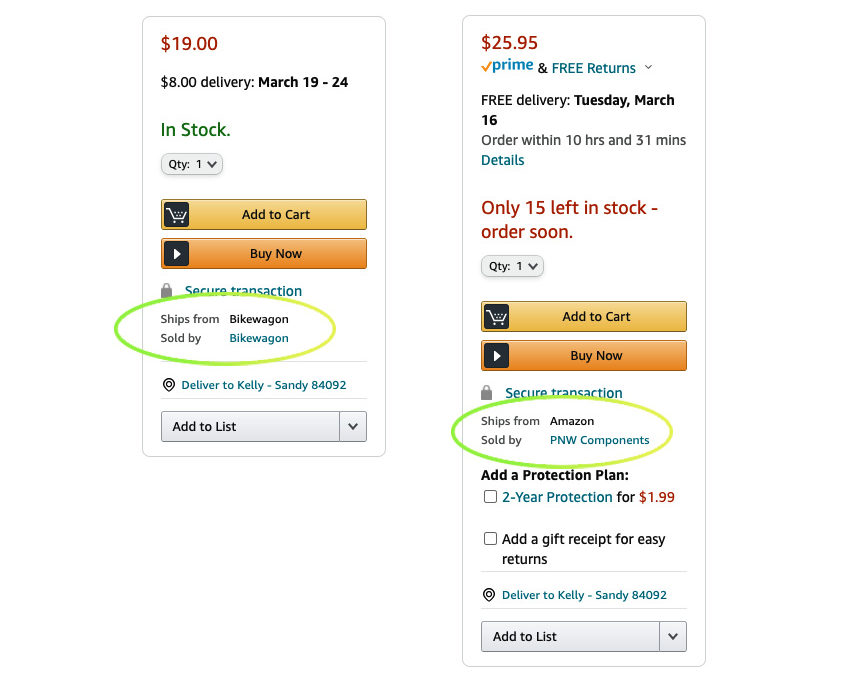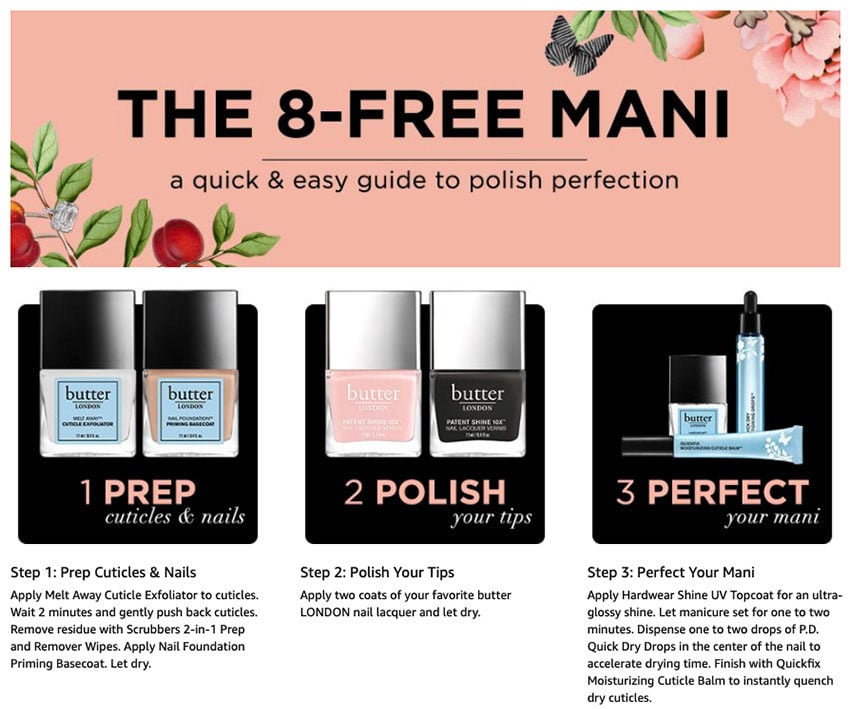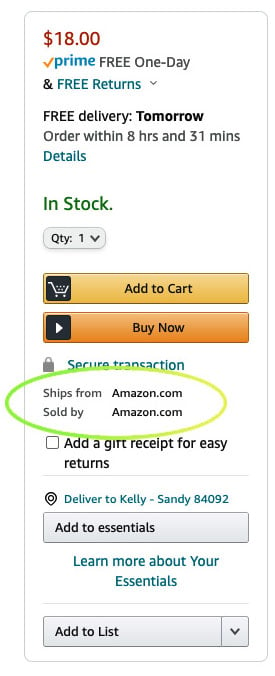Almost every company that sells on Amazon starts out as an Amazon Seller. Some Sellers (and even a very few other companies) are then invited to become an Amazon Vendor. Each has its own advantages, and disadvantages. But becoming a Vendor, doesn’t mean you have to stop being a Seller. A unique Amazon sales strategy is to choose to stay a Seller when you become a Vendor.
Before I dig into this hybrid sales strategy, why you might choose it, and how you can use it to boost sales on Amazon, let’s look at what a Vendor and Seller are and what advantages and disadvantages each has.
What Is an Amazon Seller?
Amazon Sellers are companies that sell their products directly to consumers on amazon.com. Sellers are also known as third-party (3P) sellers. Amazon Sellers warehouse and ship their own products directly to Amazon customers (known as Fulfilled by Merchant or FMB). Or for a fee, Sellers can use Fulfilled by Amazon (FBA) and have Amazon warehouse and ship the products.
When you see a notation in the “add to cart” area on Amazon that reads “Ships from ‘Your Store’” and “Sold by ‘Your Store,’” the item is an Amazon Seller item using FBM. If you see “Ships from Amazon.com” and “Sold by ‘Your Store,’” the item is an Amazon Seller item using FBA.
You can sign up to be an Amazon Seller even if you don’t have anything to sell yet.

An example of Fulfilled by Merchant (FBA) (left) and Fulfilled by Amazon (FBA) (right).
What to Expect as an Amazon Seller
Amazon Sellers have access to Seller Central, an online portal for managing and monitoring sales, inventory and product mix, pricing, buyer communications, and accessing support.
Sellers can also use Amazon Advertising Services, such as Sponsored Brands Ads, to market products to amazon.com shoppers.
Advantages of Being an Amazon Seller
The advantages of being an Amazon Seller include that:
- You’re independent from Amazon and own and control your pricing, margins, and customer data. (This could also be a disadvantage depending on your resources.)
- You have access to Seller Support from Amazon.
- You can choose FBA (for a fee).
- You access detailed analytics about your sales and directly communicate with customers.
- You control your promotions and can run Prime Day promotions and access A+ content.
- With 40+ sales a month, you can upgrade to a Pro account and compete for the Buy Box and other benefits.
- You have easy access to sell into foreign markets and can use a single account to sell into multiple countries.

An example of A+ content on amazon.com, which is available to both Amazon Sellers and Amazon Vendors.
Disadvantages of Being a Seller
The disadvantages of being an Amazon Seller are that:
- You pay a fee and commission for each item sold.
- Unless using FBA, you have to manage all inventory and shipping, returns, and other logistics (can be an advantage too).
- You’ll pay more to Amazon in fees than you will as a Vendor; however, setting your price offsets some of those fees.
- The absence of “Sold by Amazon” worries some consumers and is shown to reduce overall sales volume.
What Is an Amazon Vendor?
Amazon Vendors are companies that sell their products in bulk for wholesale prices directly to Amazon. Amazon owns the products, warehouses them, sells them to customers on amazon.com, ships the products to customers, and handles all returns and customer service. Vendors are also known as first-party (1P) sellers.
When you see a notation in the “add to cart” area on Amazon that reads “Ships from Amazon.com” and “Sold by Amazon.com,” the item is an Amazon Vendor item.
You can’t sign up to be an Amazon Vendor. A vendor relationship with Amazon is pretty much by invitation only. You can use the Contact Us link on the Vendor Central site to ask to become a vendor, but you may or may not get a response.
The reason Vendors are invited to participate is that Amazon, like any business, wants to sell products it can be successful with. So having a popular product that’s well-marketed helps.
Starting as a seller can help you become a Vendor too. More on that below.

What to Expect as an Amazon Vendor
Amazon Vendors have access to Vendor Central, an online portal for managing your relationship with Amazon, including shipments, invoices, and inventory. It includes access to Amazon Advertising Services where you can market your products to Amazon shoppers — yes, you can pay to market the products you’ve sold to Amazon.
Top Amazon Vendors can also buy in to Amazon Vendor Services (AVS). When you use AVS, you have access to a specialist to help manage your Amazon business from within Amazon. You can pay for a dedicated specialist or choose a lower tier of support for a lower cost. Membership gives you access to some 80 different growth-focused services, including advice, advertising and promotions, logistics and inventory support, and product launches.
Deciding to use AVS and at which tier is a significant long-term decision — one that has a financial impact on your whole company. Finch is happy to consult with you on this decision and to recommend best practices for dealing with AVS.
Advantages of Being an Amazon Vendor
The advantages of being an Amazon Vendor include that:
- Your products enjoy premium placement on Amazon.com and are sold under the Amazon name.
- You can potentially enjoy higher sales volumes.
- You don’t have to handle customer service, returns, fulfillment, and other logistics — Amazon does it for you.
- You have access to enhanced promotion opportunities, including Prime Day promotions, A+ content, Amazon Vine, and Subscribe & Save.
- You access unlimited sales for a flat monthly rate.
Disadvantages of Being a Vendor
Disadvantages of being a Vendor include:
- Fees for Amazon to sell for you are built into your sales price to Amazon — Amazon takes those “fees” from you by paying you less per item you sell them. (Sellers pay fees too in the form of Fulfilled by Amazon [FBA].)
- You make lower margins. And Amazon will want to negotiate you down each year.
- Amazon owns the product and decides what to sell it for and how to list it on amazon.com.
- Amazon doesn’t always honor minimum advertised pricing (MAP), which if you sell through multiple distributors can be problematic.
- Support services for Vendors are light to nonexistent.
- It can be difficult to meet Amazon’s strict Vendor requirements and to keep enough inventory at Amazon; Amazon tends to warehouse little inventory. Vendors who don’t meet requirements can incur chargebacks.
- It may be difficult to get Amazon to take new products and product lines.
- You pay extra to access analytics to learn about what’s selling or why and have no access to customer data.
- If you sell cross-border, you need a unique Vendor Central account for each country you sell in.
Now that I’ve covered the basics of what an Amazon Vendor and Seller are along with the advantages and disadvantages of each, let’s look at using being both a Vendor and a Seller as an Amazon sales strategy.
Sell as Both a Seller and a Vendor as an Amazon Sales Strategy
Here’s a unique approach to managing your Amazon sales — be both a Vendor and a Seller — sometimes called the hybrid approach.
Start as a Seller
Anyone can become an Amazon Seller. So, unless Amazon has already asked you to become a Vendor, start as a Seller.
You can launch products as a Seller and use the control you have over pricing and availability to test pricing, test and build the popularity of products, and get reviews. As your product grows in popularity, you can choose to scale and sell them as a Vendor if invited.
Don’t give up your Amazon Seller account if you become a Vendor though. Keep it. And keep selling products as a Seller — just not the same products Amazon sells for you as a Vendor.
If you want to test variations of the same products, give the product on your Seller account a different SKU, name, and description than the one on your Vendor account. Make sure Amazon knows what you’re doing too. In its US version of “Standards for Brands Selling in the Amazon Store” states, “…to prevent customer confusion, if any of the Brand’s products are sold by Amazon, the Brand may not also sell those products as a seller in the Amazon store.”
Scale as a Vendor for High-Volume Products
If Amazon invites you to become a Vendor and your business will benefit from the higher sales volume you get as a Vendor, do it for select products. Of course, ensure you’re okay with what being a Vendor requires and means, including getting lower margins on your products. Also, ensure you can keep inventory regularly flowing into Amazon’s warehouse.
An Amazon Sales Strategy that Gives You the Best of Both Worlds — Selling as a Vendor and a Seller
Selling as both an Amazon Vendor and Seller may sound counterintuitive, but it offers a lot of benefits.
While selling as both a Vendor and Seller means you’re competing with yourself in some ways, you actually can learn a lot from the analytics on Seller Central that you can’t access on Vendor Central (unless you pay for it). As a Seller, you own your customer data, so you can build email lists and information on customer demographics that you can’t as a Vendor.
You can run promotions and do advertising on your products as a Seller to learn what drives more sales also. You can test new products, product pricing and margins, new product colors, or other new product features as a Seller before having Amazon sell those products under your Vendor account. You can also use the higher margins from offering the new product as a Seller to invest in marketing for the product before you move it to your Vendor account.
Once a product sales “take off,” you can then move the product entirely to your Vendor account and focus on other new products and lower-selling seasonal and higher-touch products instead.
What Not to Sell as a Vendor
It’s typically best to sell lower-priced items under your Seller account — for example that sell for less than $15. Selling lower priced items as a Vendor is most successful and works well for large brands with popular products. For many companies though the margins on selling low-priced items as a Vendor aren’t worth it.
Also carefully consider whether or not selling seasonal items will work for your when sold under your Amazon Vendor account.
Dos and Don’ts of Selling Products as a Vendor and Seller
| Do | Don’t |
|
|
Add an Effective Advertising Strategy to Your Sales Strategy
If your goal is to have Amazon sell a product for you as a Vendor, a good way to get there is to have a popular product. That requires a great, desirable product that people know about. A great way to spread the word is to offer your product on amazon.com as a Seller and use Amazon Advertising to make sure people know about your product.
Learn more about Sponsored Brands on Amazon Advertising and contact Finch if you’d like help with your paid advertising strategy and management.






